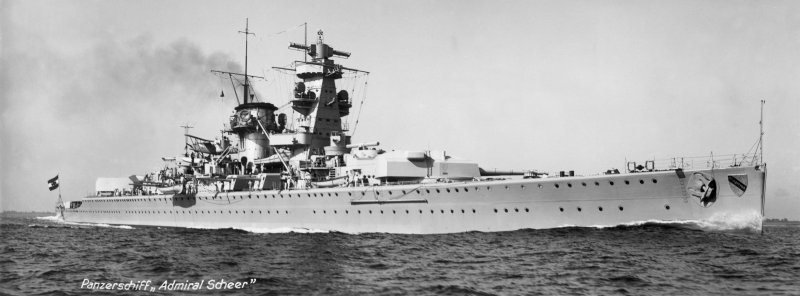Sunday Battleship Blogging: Admiral Scheer
 The Treaty of Versailles limited the German navy to vessels of 10000 tons or less. The intention was to prevent Germany from constructing any ships larger than coastal defense vessels, although the letter of the Treaty allowed Germany to build ships as large as Washington Treaty heavy cruisers. Using the most advanced construction techniques possible, the Germans decided to circumvent the Treaty by building capital ships within the legal limits.
The Treaty of Versailles limited the German navy to vessels of 10000 tons or less. The intention was to prevent Germany from constructing any ships larger than coastal defense vessels, although the letter of the Treaty allowed Germany to build ships as large as Washington Treaty heavy cruisers. Using the most advanced construction techniques possible, the Germans decided to circumvent the Treaty by building capital ships within the legal limits.
Germany had used surface commerce raiders to good effect in World War I, and decided that purpose-built ships might do an even better job. Given the Treaty limitations, Germany could not hope to equal the Royal Navy in any case, so commerce raiding was a natural option. Admiral Scheer, the second Panzerschiff, displaced about 12000 tons while carrying 6 11″ guns in two triple turrets, and could make 28.5 knots. Scheer used diesel engines to provide for greater range. The Germans saved weight through the use of welding and a relatively light armor scheme. The German hope was that Admiral Scheer and his (Admiral Scheer is one of a very few ships referred to in the masculine) sisters could outrun any foe that they could not outgun. It’s unclear whether Scheer could have been expected to defeat a standard Washington Treaty cruiser, as such cruiser had more guns that fired more rapidly, and the armor scheme of Panzerschiff was not sufficient to protect from 8″ shells. In any case, Scheer was clearly outclassed by the three British battlecruisers. The construction of Dunkerque and Strasbourg by France cemented the obsolescence of the Panzerschiff type, and the last two ships were cancelled.
Obsolescence has never stood in the way of employment during war. Admiral Scheer was used by the Nazis to aid the Nationalist side in the Spanish Civil War, firing on Republican positions and escorting Nationalist convoys. He underwent an overhaul and refit at the beginning of the war, and did not participate in the invasion of Norway. In October 1940 Scheer set out on a raiding cruise that lasted nearly eight months and took him into the Indian Ocean. On the cruise Scheer managed to sink sixteen ships with a total displacement of over 100000 tons. Although the raid was a success, it didn’t compare all that favorably in cost-effectiveness to U-boats or even to converted merchant cruiser raiders. In August 1942 Admiral Scheer sortied against Arctic convoy PQ-17, which was scattered in response with extremely heavy loss to submarines and Luftwaffe aircraft. In August he sortied again, shelling a Soviet weather station and sinking a Soviet icebreaker. Hitler became disillusioned with the surface fleet after 1942, and Scheer rarely left port for the next two years.
 In late 1944 the German situation in the Baltic began to rapidly deteriorate. Scheer escorted escaping ships and supplied artillery support for retreating German forces. He returned to Kiel in April, 1945 and was sunk by an RAF attack. The wreck was partially broken up after the war, and the area in which the hull lay filled in with rubble and covered to serve as a parking lot.
In late 1944 the German situation in the Baltic began to rapidly deteriorate. Scheer escorted escaping ships and supplied artillery support for retreating German forces. He returned to Kiel in April, 1945 and was sunk by an RAF attack. The wreck was partially broken up after the war, and the area in which the hull lay filled in with rubble and covered to serve as a parking lot.
Trivia: What Royal Navy dreadnought did not participate in either World War I or World War II?
UPDATE: In comments, Martin asks why Scheer was known as a “he”. Discussion here; all other examples of masculine ships are Kriegsmarine vessels named after men, which tells me that it has something to do with the Nazi construction of masculinity. The captain of Bismarck, apparently, ordered his crew to use the masculine because of Bismarck’s great power.
While researching the question, I found that the crewmen of Yamato commonly referred to her as “more beautiful than any woman,” which is kind of sweet.


